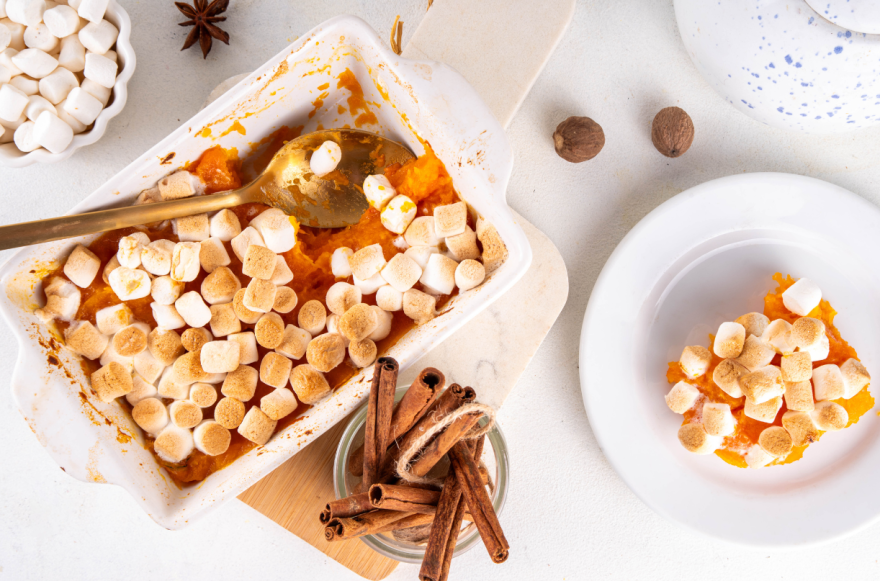Last November, I wrote about pie vs. cake at Thanksgiving. It sounded like a good idea at the time. In a conversation with Scott Horsley, NPR's Chief Economics Correspondent, and, I believe, an official pie contest judge, he pretty much said “good luck with that” as we know that pie is the official Thanksgiving dessert.
So, when my colleague, Scott Thornton, gave me an idea for this November, I thought I better not ignore another Scott. He said, “Why don’t you talk about candied sweet potatoes?"
Good idea, Scott. I thought about my mother’s recipe right away because she made the best. But her recipe is for candied yams—not sweet potatoes.
So, what’s the difference? We use yams and sweet potatoes interchangeably, but they aren’t even from the same family. Yams are edible tubers found in Africa and Asia belonging to a flower plant that you might know—the Lily family. They have a rough bark-like brown skin, white or yellow-ish flesh, and are larger than sweet potatoes, usually weighing 6-11 pounds.
Sweet potatoes are root vegetables, not tubers. They are the actual root of the plant, native to Central and South America and belonging to the Morning Glory family. Their skin is smooth; their flesh sweeter than yams—they can be white, orange or purple—with 16 common varieties and weighing 5-7 ounces. Those sweet potato fries that you may like are made from the Garnet variety.
How did we come to link these two non-relatives together in America? Enslaved Africans referred to the new sweet potatoes as “yams” because it reminded them of the African yams they used to eat. The name stuck, and Americans started calling sweet potatoes yams. Also, orange sweet potatoes needed to be distinguished from white-fleshed sweet potatoes as a way for growers to differentiate one crop from the other, so “yam” was used for orange vs white sweet potatoes.
In the 1930s, the USDA allowed Louisiana to brand the bright orange Puerto Rican variety of sweet potato as a yam. That was an incorrect designation, but by using the name “yam,” Louisiana distinguished its sweet potato from inferior varieties grown at the time, in Virginia and Maryland, allowing the mistake to continue.
Speaking of growers, North Carolina has been the top grower for over 50 years, producing 60% of our sweet potatoes. However, Vardaman, Mississippi—population 1,068—is the “self-proclaimed” capital, noted for the quality of their sweet potatoes and famous for the National Sweet Potato Festival held the first week of November.
Back to candied sweet potatoes, or yams. Yes, my mother may have used sweet potatoes and not yams. Whatever she used, they were yummy—loaded with butter, sugar, cinnamon, and a little nutmeg and allspice.
For the best sweet potato anything—candied, in a casserole, roasted, mashed, or as a southern tradition in a pie or biscuits—use fresh ones as they are in abundance. You want to use the Covington variety for those if you can.
The canned ones are good, of course. Rumor has it that the best brands are Sugary Sam, Happy Harvest, Bruce’s and Princella’s—but I don’t have a dog in the fight, so I would eat any of those.
Hey, before I go…
Consider starting your Thanksgiving feast with a relish tray—it has made a comeback. Not to be confused with a charcuterie board, which has cheese, meat, and bread, the relish tray, a Midwest get-the-party started-staple is a combination of mix-and-match dips, veggies and crackers—and lots of pickled stuff like olives, sweet gherkins, and green beans.
Here’s to a delicious Thanksgiving!



